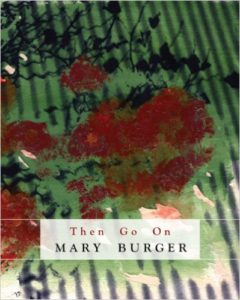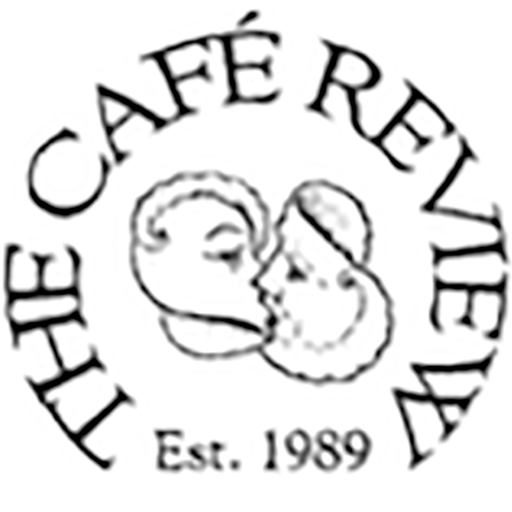Then Go On
 by Mary Burger.
by Mary Burger.
Litmus Press, 2012,
93 pages, paper,
ISBN: 978-1-933959-14-6.
Buy the Book
When I read the poems in Mary Burger’s Then Go On, I have the feeling of floating up along the ceiling, up near the maple-leaf molding, up where the day’s heat collects. From this elevated, even light-headed, position, I observe the world of my parlors, and I find the surprisingly precise ability (I am, after all, hovering fourteen feet in the air, and I do not usually find myself at such a perspective — I am not such a light person!) to point with confidence and name exactly what I see. This experience is like a version of “I Spy”: “I spy with my little eye. . . . ” What I spot is not limited to the child-like — a fire truck, a tiger, two little
mice — but also includes floating abstractions: accepted premises, optimism, futurity, arbitrariness, and synesthesia. This is indeed a heady game, not only for the range of pointed-at things, but more so for the confidence Burger inspires in my otherwise rather doubtful pointing. After all, as a reader, I am not all that confident in my ability to identify “synesthesia of attachment,” for example, but with these poems, I find myself an “I Spy” master. I’m hitting everything: Social Identities, Energy, Light, Chairs and Plastic Farm Animals.
Burger’s book is perhaps most poignant when its author, so comfortable in helping readers hit new philosophical ground, really grounds us in her reality. Poems like “Fire Cat” do that easily, bringing the reader through the phonetic poem of a seven year old:
A small hole appears in the middle, a dot of white in the
moving
image, and spreads toward the edges of the frame, orange and
black and white
and blistering, eating the shapes around it, hungry
microphage,
until it eclipses even itself and there is only
white, light, unimpeded, unfilmed, unfiltered. . . .
i like tuu bee a fier cat.
I too like when Burger is a fire cat. Her crackling language can roar back words telescopically through space and time to aid this reader in hearing the constant soft-sound drone of Interstate 70 that passes far from, but near, my parents’ house in Southeast Ohio. From “Energy, Light”:
The background roar of the distant highway, that some might
hear as an explanation of origin, that some might regard like
the microwaves that permeate the universe, evidence of the
beginning, of the beginning of the real. . . .
I felt grateful that Burger so quickly took me back to this sound memory.
Later, she’s downright funny in the poem “Snoring is Waking,” in which the narrator butters toast at 3 am, blithely battles with her bed partner, Snoring, who does not suffer the narrator’s insomnia. It’s this tension between the ignorant bliss of Snoring and the narrator’s wakeful amazement at Snoring’s ability to sleep that gives the piece its spark. Anyone who has laid awake at night staring incredulous and jealous at a partner’s supine slumber will especially appreciate.
The other piece that stuck out to me was the commiseratingly conspiratorial “All New Yorker Stories.” As broad as the title may at first appear, Burger’s analysis rings startlingly true. The piece deconstructs two actual New Yorker stories, one from Mary Karr and one from J. Robert Lennon. It’s humorous — see reference to Kevin Spacey’s character in American Beauty — but after reading the piece, it left me mightily impressed by Burger’s analytic ability as a far-from-the-mainstream artist to so brazenly and insightfully lay bare the establishment.
This returns me to “I Spy,” and my happy, languid, peaceful floating along my parlor ceiling. I want to take this confident pointing from the pages of Then Go On out into the outside world. After all, I could use — and who couldn’t ? — a little extra brazenness against the establishment. The book is a pocket guide for such insurgences of sight.
— Jefferson Navicky

